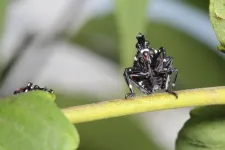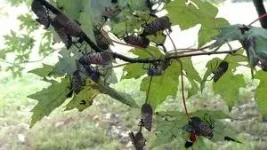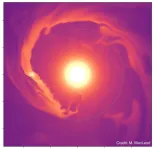(Press-News.org) UNIVERSITY PARK, Pa. — In 2012, when the spotted lanternfly (Lycorma delicatula) arrived in the U.S. from its home in China, scientists, land managers, and growers were understandably concerned that the sap-feeding insect would damage native and commercial trees. New long-term research led by Penn State has discovered that hardwood trees, such as maple, willow and birch, may be less vulnerable than initially thought.
“Since the lanternfly was first introduced to the northeastern U.S., the question has been, ‘How at-risk are our forests?’ said Kelli Hoover, professor of entomology at Penn State. “So far, we haven't had a good answer. Our study is the first to look at the long-term impacts of feeding pressure on northeastern hardwoods, and our results suggest that we are unlikely to see big impacts on the growth of trees.”
The findings published in the journal Environmental Entomology on August 29.
To determine the long-term effects of spotted lanternfly (SLF) feeding on hardwood trees, the team built large enclosures containing multiple species of tree, including the insect’s favorite food, the non-native tree-of-heaven (Ailanthus altissima), as well as native trees, including silver maple (Acer saccharinum), weeping willow (Salix babylonica) and river birch (Betula nigra). The team included tree-of-heaven in half of the enclosures to determine whether its presence would influence the feeding pressure on the native hardwoods.
Within the enclosures, the researchers reared different densities of spotted lanternflies for all or most of their lifecycle, from eggs through adults, to see if the number of insects feeding on a tree would impact its growth and survival. After the first two years, they reduced the density of the insects to see if trees would recover. They monitored leaf gas exchange and concentrations of nutrients that are important for photosynthesis and growth for the first two years and tree diameter growth for the full four years.
The team found that increased feeding pressure by spotted lanternfly resulted in reductions in key nutrients, which in turn, markedly impacted tree diameter growth during the first two years when feeding pressure was the most intense. However, in year three when the feeding pressure was reduced, the native trees recovered while tree-of-heaven’s growth remained flat. Leaf gas exchange did not differ significantly among the treatments.
“In the wild, we have seen that spotted lanternfly population numbers vary greatly from year to year on individual trees, and they move frequently among host trees,” Hoover said. “Our study represents a worst-case scenario in which the spotted lanternfly fed on the same trees for four consecutive growing seasons. While we did see reduced growth after two years of intense feeding, the native trees recovered when feeding was less intense. Importantly, over the four years, none of the trees died. Therefore, in a natural setting where the insects are constantly on the move, we would not expect significant negative impacts on forest or ornamental trees.”
Hoover noted that these findings may come as a relief to growers.
She said, “If I had an apple or peach orchard, I wouldn't even treat my trees with insecticides because we’ve learned that the insects are not going to stick around, and the cost of treating and the potential non-target impacts of the insecticides are just not worth it.”
Other authors on the paper include Lidiia Lavorivska, postdoctoral fellow, Penn State; Emily Lavely, tree fruit educator, Michigan State University; Osariyekemwen Uyi, research scientist, University of Georgia; Brian Walsh, extension educator, Penn State; Emelie Swackhamer, extension educator, Penn State; Anne Johnson, graduate student in entomology, Penn State; and David Eissenstat, professor emeritus of woody plant physiology, Penn State.
The U.S. Department of Agriculture and Pennsylvania Department of Agriculture supported this research.
END
Invasive spotted lanternfly may not damage hardwood trees as previously thought
2023-09-01
ELSE PRESS RELEASES FROM THIS DATE:
$26M NIH grant addresses environmental influences on child health
2023-09-01
EAST LANSING, Mich. – Backed by a $26 million federal grant, researchers at three Michigan universities, a leading health care system, and a state agency will continue a long-term study of how exposure to environmental factors during pregnancy and early childhood can impact health for a lifetime.
The funding from the National Institutes of Health, or NIH, is for the second phase of a national research program called ECHO, which stands for the Environmental Influences on Child Health Outcomes, and includes a sample of mothers, infants and children from across the United States. The first phase began in 2016.
“This award shows the research ...
LDL not the be all, end all in heart disease, heart attacks and stroke
2023-09-01
Milwaukee, Wis. – Sept. 1, 2023 – Despite advances in treatment for high cholesterol, heart disease remains the leading cause of death in the U.S. Scientists at the Medical College of Wisconsin (MCW) are investigating the role of a form of cholesterol called very-low-density lipoprotein – and their findings may lead to new treatment options in the future.
The research team is led by Ze Zheng, MBBS, PhD, MCW assistant professor of medicine (endocrinology and molecular medicine); co-leader of the MCW Cardiovascular Center’s Atherosclerosis, Thrombosis ...
Hot Jupiter blows its top
2023-09-01
A planet about 950 light years from Earth could be the Looney Tunes’ Yosemite Sam equivalent of planets, blowing its atmospheric ‘top’ in spectacular fashion.
The planet called HAT-P-32b is losing so much of its atmospheric helium that the trailing gas tails are among the largest structures yet known of an exoplanet, a planet outside our solar system, according to observations by astronomers.
Three-dimensional (3D) simulations on the Stampede2 supercomputer of the Texas Advanced Computing Center (TACC) helped model the flow of the planet’s atmosphere, ...
Kidder receives American Chemical Society’s 2023 Mid-Career Award
2023-09-01
Michelle Kidder, a senior R&D staff scientist at the Department of Energy’s Oak Ridge National Laboratory, has received the American Chemical Society’s Energy and Fuels Division’s Mid-Career Award for sustained and distinguished contributions to the field of energy and fuel chemistry. She was recognized for her scientific community service, leadership and contributions. Her research focuses on novel material development, methods and advanced characterizations for the separation and reaction chemistry of renewable energy resources including lignin and carbon dioxide.
Kidder, ...
Mukherjee elevated to senior member of IEEE
2023-09-01
Subho Mukherjee, an R&D associate in the Vehicle Power Electronics Research group at the Department of Energy’s Oak Ridge National Laboratory, has been elevated to the grade of senior member of the Institute of Electrical and Electronics Engineers, or IEEE. Senior IEEE members have made significant contributions to the profession and worked in the engineering field for 10 years or more.
As an electrical engineer, Mukherjee focuses on wireless power charging and developing wide bandgap semiconductor-based ...
SMART-BARN – a cutting-edge technology lab to study animal groups
2023-09-01
Researchers from the Cluster of Excellence Centre for the Advanced Study of Collective Behaviour (CASCB) and the Max Planck Institute of Animal Behavior have converted a former barn into a cutting-edge technology lab for complex behavioral analysis. In it, they can now study the intricate behaviour of animal groups. The barn also served as a prototype for the largest swarm behaviour lab at the University of Konstanz: the Imaging Hangar.
A major limitation in behavioural research is that scientists can either study animals under highly-controlled, yet often unrealistically simplified and ...
Immune cells shape their own path
2023-09-01
When fighting disease, our immune cells need to reach their target quickly. Researchers at the Institute of Science and Technology Austria (ISTA) now discovered that immune cells actively generate their own guidance system to navigate through complex environments. This challenges earlier notions about these movements. The researchers’ findings, published in the journal Science Immunology, enhance our knowledge of the immune system and offer potential new approaches to improve human immune ...
Network-based approaches open a new avenue to classify and treat rare diseases
2023-09-01
Scientists at CeMM, Max Perutz Labs, and St. Anna Children’s Cancer Research Institute in Vienna have achieved a significant advancement in the research of rare immune system disorders. Through a network-based approach, they have reclassified approximately 200 rare diseases. Initial comparisons with clinical data already demonstrate how this can enhance the prediction of treatment efficacy. Moreover, the study reveals for the first time the strong similarities between the molecular mechanisms of rare diseases and ...
Warming climate worsens groundwater depletion rates in India
2023-09-01
Increased withdrawals of groundwater resources are accelerating groundwater depletion rates in India, a groundwater depletion hotspot, a new study finds. The study, published today in the journal Science Advances, is led by University of Oklahoma Department of Geography and Environmental Sustainability assistant professor Nishan Bhattarai.
Bhattarai and his collaborators found that under a business-as-usual scenario of groundwater use for irrigation, warming may triple the groundwater depletion rates. Approximately 60% of India’s irrigated agriculture depends on the threatened groundwater. The results of the study indicate that adaptation ...
Groundwater depletion rates in India could triple in coming decades as climate warms, study shows
2023-09-01
EMBARGOED FOR RELEASE AT 2 P.M. ET FRIDAY, SEPT. 1, 2023
Photos
ANN ARBOR—A new University of Michigan-led study finds that farmers in India have adapted to warming temperatures by intensifying the withdrawal of groundwater used for irrigation. If the trend continues, the rate of groundwater loss could triple by 2080, further threatening India's food and water security.
Reduced water availability in India due to groundwater depletion and climate change could threaten the livelihoods of more than one-third of the country's 1.4 billion ...










